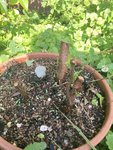sorce
Nonsense Rascal
I'd like to know what folks think about the difference between potting an airlayer in summer and repotting a tree.
In reading this thread about layer removal, I got thinking about how it's the same thing.
Same questions....should I cut it back, how many roots? Blah blah.
I consider removing Airlayers much more stressful a process to survive than repotting. We do this all the time with no thought at all. Usually successfully, and no one bats an eye.
But because of the Human Argument involved in "repotting times", we fill our heads with bullshit lies that make is think we can't do it.
It's all in our heads.
Is it not?
Sorce
In reading this thread about layer removal, I got thinking about how it's the same thing.
Same questions....should I cut it back, how many roots? Blah blah.
I consider removing Airlayers much more stressful a process to survive than repotting. We do this all the time with no thought at all. Usually successfully, and no one bats an eye.
But because of the Human Argument involved in "repotting times", we fill our heads with bullshit lies that make is think we can't do it.
It's all in our heads.
Is it not?
Sorce














